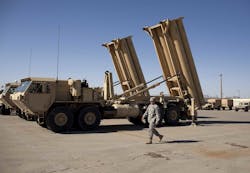Missile Defense Agency (MDA) orders six more THAAD launchers to help defend against enemy ballistic missiles
HUNTSVILLE, Ala. – Missile defense experts at Lockheed Martin Corp. will build six missile-defense rocket launchers and fire-control systems for the U.S. military to protect against incoming ballistic missiles under terms of a $$74.1 million order announced Friday.
Officials of the U.S. Missile Defense Agency (MDA) in Huntsville, Ala., are asking the Lockheed Martin Missiles and Fire Control segment in Dallas to build six Terminal High Altitude Area Defense (THAAD) launchers, THAAD Fire Control and Communication (TFCC) systems, and support equipment.
THAAD is designed to shoot down short-, medium-, and intermediate-range ballistic missiles in their terminal phase using a hit-to-kill kinetic warhead. The THAAD interceptor missile relies on the kinetic energy of the impact to destroy the incoming missile.
THAAD consists of five major components: the launcher, interceptor, radar, THAAD fire control and communications (TFCC) units, and support equipment. Last month Lockheed Martin won a $1.4 billion order for infrared-guided missile-defense rocket interceptors.
The THAAD launcher is based on a four-axle heavy expanded mobility tactical truck (HEMTT). Each launcher carries as many as eight interceptors, which are housed in 22-foot launch canisters. A typical THAAD battery includes six launchers, and each launcher takes as long as 30 minutes to reload. A THAAD launcher vehicle has two mobile tactical operations centers (TOCs) and the AN/TPY-2 ground-based radar (GBR).
The THAAD TFCC oversees battery operations and relays fire-control information to other warfighters. Each system has a tactical operations station with two operating stations; a launch control station, which includes wireless datalinks, networking equipment, and fiber optic cable interfaces; and a station support group with antenna and cable support.
These systems control battery launch operations and transfer fire control information from the AN/TPY-2 radar to the larger command, control, battle management, and communications (C2BMC) network.
Related: Wanted: THAAD upgrades using MOSA, open-systems standards
THAAD is a key element of the U.S. ballistic missile-defense system to defend the continental United States, its deployed forces, and allies against ballistic missiles of all ranges and in all phases of flight.
Lockheed Martin started developing the THAAD system in 1992, and first tested the system three years later. The first THAAD tests that hit their targets were in 1999, after the first six ballistic missile-defense tests missed. THAAD missiles, which have a maximum range of about 125 miles, are expected to hit incoming ballistic missile warheads as high as 93 miles above the Earth's surface.
On this order Lockheed Martin will do the work in Dallas; Sunnyvale, Calif.; Huntsville and Troy, Ala.; and Camden, Ark., and should be finished by August 2027. For more information contact Lockheed Martin Missiles and Fire Control online at https://www.lockheedmartin.com/en-us/who-we-are/business-areas/missiles-and-fire-control.html, or the Missile Defense Agency at www.mda.mil.
About the Author
John Keller
Editor-in-Chief
John Keller is the Editor-in-Chief, Military & Aerospace Electronics Magazine--provides extensive coverage and analysis of enabling electronics and optoelectronic technologies in military, space and commercial aviation applications. John has been a member of the Military & Aerospace Electronics staff since 1989 and chief editor since 1995.
